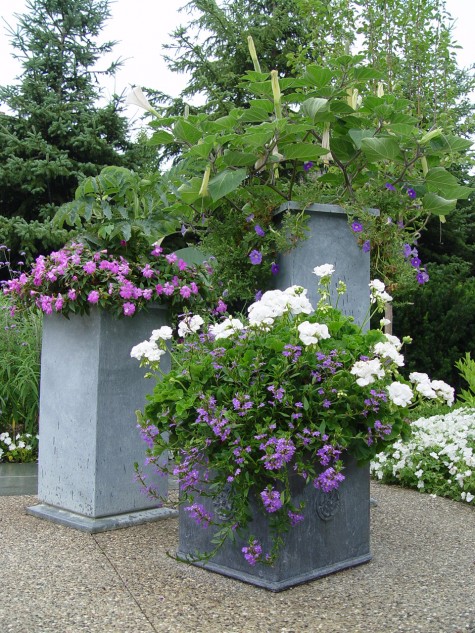 I sold this lead fountain cistern 3 days ago. Stunning-isn’t it? I so clearly remember a constellation of feelings regarding its purchase, some years ago. I was afraid to commit so hefty a chunk of my budget to one ornament. I was equally afraid not to commit to it; I am in the business of making first class garden ornament available to my clients. Some first class ornament involves only a great eye, and not so much money. But lead garden ornament, both new and antique, is very expensive. You may think that committing to a very expensive garden ornament takes nerve. Truth be told, I would not describe myself as nervy. I try to focus on what I cannot live without. Lead in the garden-this I would want.
I sold this lead fountain cistern 3 days ago. Stunning-isn’t it? I so clearly remember a constellation of feelings regarding its purchase, some years ago. I was afraid to commit so hefty a chunk of my budget to one ornament. I was equally afraid not to commit to it; I am in the business of making first class garden ornament available to my clients. Some first class ornament involves only a great eye, and not so much money. But lead garden ornament, both new and antique, is very expensive. You may think that committing to a very expensive garden ornament takes nerve. Truth be told, I would not describe myself as nervy. I try to focus on what I cannot live without. Lead in the garden-this I would want.
 Lead in the garden has long history. English lead ornament has a long long history-this I respect. Lead is poured into molds, and cooled. An artist takes the castings from a raw set of molds, and hammers and sculpts the lead into the finished ornament. A large lead egg cup may take 60 hours of hand work to finish. The finished ornament is very heavy; lead is the densest of all the elements. It is equally as soft. This makes it difficult to transport, and easy to damage. Yet lead is the ideal material for a garden ornament; it is all but impervious to weather and maintenance-free.
Lead in the garden has long history. English lead ornament has a long long history-this I respect. Lead is poured into molds, and cooled. An artist takes the castings from a raw set of molds, and hammers and sculpts the lead into the finished ornament. A large lead egg cup may take 60 hours of hand work to finish. The finished ornament is very heavy; lead is the densest of all the elements. It is equally as soft. This makes it difficult to transport, and easy to damage. Yet lead is the ideal material for a garden ornament; it is all but impervious to weather and maintenance-free.
 The English company known as Bulbeck produces very fine lead garden ornament. Pots, sculptures, fountains and cisterns. Hugo flew over, and paid a visit to us some years ago-he was so pleased that an American garden store was featuring his work. I have four of his lead egg cups available now. They are based on pots from the National Trust garden Anglesey Abbey, and feature four medallions-pears, oak, roses and grapes. I doubt I will be able to buy more, once these four egg cups are sold. The cost of lead has increased so dramatically in the past few years, as has the cost of transport.
The English company known as Bulbeck produces very fine lead garden ornament. Pots, sculptures, fountains and cisterns. Hugo flew over, and paid a visit to us some years ago-he was so pleased that an American garden store was featuring his work. I have four of his lead egg cups available now. They are based on pots from the National Trust garden Anglesey Abbey, and feature four medallions-pears, oak, roses and grapes. I doubt I will be able to buy more, once these four egg cups are sold. The cost of lead has increased so dramatically in the past few years, as has the cost of transport.
 Eighteenth century lead ornament has inspired many of the pieces produced at the Bulkbeck foundry-and no wonder. The production of lead garden ornament and architectural pieces was a flourishing business during that period. Only a few companies deal in lead now; I hope their business stays strong. It has been my pleasure to design and plant around lead ornament; to follow are a few pictures.
Eighteenth century lead ornament has inspired many of the pieces produced at the Bulkbeck foundry-and no wonder. The production of lead garden ornament and architectural pieces was a flourishing business during that period. Only a few companies deal in lead now; I hope their business stays strong. It has been my pleasure to design and plant around lead ornament; to follow are a few pictures.
 lead tapers with grape garlands
lead tapers with grape garlands
 English lead box with lion medallions
English lead box with lion medallions
 English lead square with rose medallions
English lead square with rose medallions
 English lead square with contemporary zinc planters
English lead square with contemporary zinc planters
 This 17th century English lead cistern is near to the last of my lead. I am looking here at the very best reason I have to find more lead ornament-there is nothing else quite like it.
This 17th century English lead cistern is near to the last of my lead. I am looking here at the very best reason I have to find more lead ornament-there is nothing else quite like it.




